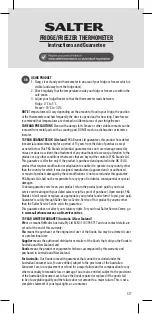
4.2 LAUDA heat transfer liquid
Note the following instructions:
The heat transfer liquids each cover a recommended temperature range
and must be suitable for the temperature range associated with their
application.
Never use contaminated or degenerated heat transfer liquids.
You can request a copy of the safety data sheets for the heat transfer
liquid at any time, if necessary.
Table 3: Approved heat transfer liquids
LAUDA
designation
Chemical
name
Temperature
range in °C
Viscosity (kin) in
mm²/s at
(at 20 °C)
Viscosity (kin) in
mm²/s at
temperature
Container size
Cat. No.
5 L
10 L
20 L
Aqua 90
Decalcified
water
5
-
90
1
¾
LZB 120 LZB 220 LZB 320
Kryo 30
Monoethylene
glycol/water
mixture
-30
-
90
4
50 at -25 °C
LZB 109 LZB 209 LZB 309
The water content decreases during longer periods of operation at
higher temperatures and the mixture becomes combustible (flash point
119 °C). Check the mixing ratio using a hydrometer.
The proportion of alkaline earth ions in the water must be between
0.71 mmol/L and 1.42 mmol/L (equivalent of 4.0 and 8.0 °dH). Harder
water leaves limescale deposits in the device.
The pH value of the water must be between 6.0 and 8.5.
Due to their corrosive properties, distilled, deionized, fully desalinated
(FD) water, or ocean water cannot be used. High-purity water and dis-
tillates are suitable as a medium after 0.1 g of soda (Na
2
CO
3
, sodium
carbonate) is added for every liter of water.
Avoid chlorine content in the water at all costs. Do not add chlorine to
the water. Cleaning agents and disinfectants, for example, contain
chlorine.
The water must be free of impurities. Water with iron content is unsuit-
able due to rust formation and untreated river water is unsuitable due to
algae growth.
The addition of ammonia is not permitted.
Heat transfer liquid Kryo 30
Heat transfer liquid, water
16 / 41
LOOP
V3
Summary of Contents for LOOP 100
Page 21: ...5 2 LOOP menu structure Fig 10 Menu structure V3 LOOP 21 41...
Page 42: ......
Page 43: ......
















































